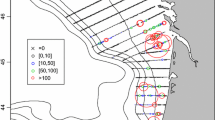Some geological events occur infrequently but still have a significant impact upon reservoir characteristics. By their very nature, however, it can be difficult to properly estimate the proportions of uncommon events because they may not appear during limited sampling. For example, even with 40 observations and an event proportion of 0.05, there is a 0.13 chance that no events will be observed. We provide some results and guidance concerning methods to estimate proportions when such events are not detected. Two cases are discussed, estimating proportions without errors in identification and estimating proportions when errors may arise.
It is well-known that the distribution of possible proportions in the error-free case can be calculated using Bayesian analysis. If one assumes a standard uniform distribution as the prior for the proportion, Bayesian analysis gives a Beta distribution for the posterior. The situation becomes more complicated, however, when detection errors are included; the true proportion has a distribution consisting of several Beta distributions. The difference in results between the error-free and with-error situations can be considerable. For example, when 10 error-free observations are made and no uncommon events are detected, there is a 0.50 chance that the true proportion exceeds 0.06 and a 0.10 chance that it exceeds 0.19. Including the effects of erroneous identifications, however, increases the median proportion to 0.09 and the upper decile to 0.27.
We also examine the case where there may be prior geological information, which can be incorporated by amending the prior distribution of the proportion. We find that the use of such a prior makes little difference unless there are very few observations or there are major differences between the anticipated and the observed proportions.
Similar content being viewed by others
REFERENCES
Bickel, P. J., and Doksum, K. A., 1977, Mathematical statistics: Prentice Hall, Englewood Cliffs, NJ, 493 p.
Blair, T., and McPherson, J., 1994, Alluvial fans and their natural distinction from rivers based on morphology, hydraulic processes, sedimentary processes, and facies assemblages: J. Sediment. Res., v. A64, no. 3, p. 450–489.
Caddel, E. M., and Moslow, T. F., 2004, Outcrop sedimentology and stratal architecture of the Lower Albian Falher C sub-Member, Spirit River Formation, Bullmoose Mountain, northeastern British Columbia: Bull. Can. Pet. Geol., v. 52, no. 1, p. 4–22.
Desbarats, A. J., 1987, Numerical estimation of effective permeability in sand-shale formations: Water Resour. Res., v. 23, no. 2, p. 273–286.
Gingras, M. K., Pemberton, S. G., Mendoza, C., and Henk, B., 1999, Assessing the anistropic permeability of Glossifungites surfaces: Pet. Geosci., v. 5, no. 4, p. 349–357.
Haas, A., and Formery, P., 2002, Uncertainties in facies proportion estimation I. Theoretical framework: The Dirichlet distribution: Math. Geol., v. 34, no. 6, p. 679–693.
Hurst, A., and Rosvoll, K. J., 1991, Permeability variations in sandstones and their relationship to sedimentary structures, in Lake, L. W., Carroll, H. B. , and Wesson, T. C., eds., Reservoir characterization II: Academic Press, New York, p. 166–196.
Johnson, N. L., Kotz, S., and Kemp, A. W., 1993, Univariate discrete distributions, 2nd ed.: John Wiley and Sons, New York, 565 p.
Kapur, L., Lake, L. W., and Sepehrnoori, K., 2000, Probability logs for facies classification: In Situ, v. 24, no. 1, p. 57–78.
Korvin, G., 1992, Fractal models in the earth sciences: Elsevier, Amsterdam, 396 p.
Lee, P. M., 1997, Bayesian statistics, 2nd ed.: Arnold, London, 344 p.
Lucia, F. J., and Conti, R. D., 1987, Rock fabric, permeability, and log relationships in an upward-shoaling, vuggy carbonate sequence: Bureau Economic Geology, University of Texas at Austin, Geological Circular 87–85, 22 p.
Newendorp, P. D., 1972, Bayesian analysis—A method for updating risk estimates: J. Pet. Technol., v. 24, no. 2, p. 193–198.
Tye, R. S., Bhattacharya, J. P., Lorsong, J. A., Sindelar, S. T., Knock, D. G., Puls, D. D., and Levinson, R. A., 1999, Geology and stratigraphy of fluvio-deltaic deposits in the Ivishak formation: Applications for development of Prudhoe Bay field Alaska: Am. Assoc. Pet. Geol. Bull., v. 83, no. 10, p. 1588–1623.
Williams, K. E., Lerche, I., and Maubeuge, F., 1998, Unconventional gas traps: Low permeability sands and gas accumulations: Energy Explor. Exploit., v. 16, p. 1–87.
Worthington, P., 2002, A validation criterion to optimize core sampling for the characterization of petrophysical facies: Petrophysics, v. 43, no. 6, p. 477–493.
ACKNOWLEDGMENT
We thank the reviewers for their timely reviews and suggestions that improved the text.
Author information
Authors and Affiliations
Corresponding author
Rights and permissions
About this article
Cite this article
Jensen, J.L., Hart, J.D. & Willis, B.J. Evaluating Proportions of Undetected Geological Events in the Case of Erroneous Identifications. Math Geol 38, 103–112 (2006). https://doi.org/10.1007/s11004-005-9007-7
Received:
Accepted:
Published:
Issue Date:
DOI: https://doi.org/10.1007/s11004-005-9007-7




